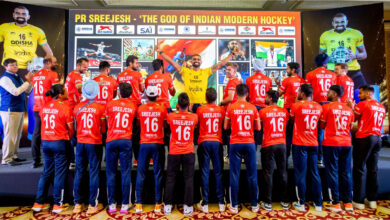Usman Khawaja’s Australia invert V: 128 runs out of 263 behind stumps

IND vs AUS: Late in the second session, Australian skipper Pat Cummins slog swept Ravichandran Ashwin for a six. The ball landed in the most crowded part of the stadium, the unroofed section with Rs 750 seats. There was a scramble among the fans to catch it, those around the scrum clapped, the ones in the back rows danced. The T20-favourite hoik didn’t quite wake up the crowd, it broke the monotony of the day’s grinding and engrossing action.
Conspicuous their absence on Day 1 at Ferozshah Kotla were the Test match staple strokes – the blazing free-flowing cover drives and the screaming down-the-ground solid push with the bowler getting a full view of the bat-maker’s name. There were a few successful ‘dancing down the track’ lofted sixes but mostly it was a day of sweeps, reverse sweeps, late-cuts, ramp shots, glances, paddle sweeps and top edges.
Australia’s Usman Khawaja plays a reverse sweep shot during the first day of the second cricket test match between India and Australia in New Delhi, India, Friday, Feb.17, 2023. (AP Photo/Altaf Qadri)
The India-Australia second Test was another reminder of the game’s oldest format changing hue. The ancient ethos of playing with the straight bat still remains irrelevant but the world is increasingly realising that they aren’t etched in stone. Even while wearing whites, a bit of colour to the batting would do no harm. Batsmen around the world were discovering the scope of innovation, they were also re-weighing the risk-to-reward ratio of strokes that for long didn’t have official entry at Test venues.
At Kotla on Friday, the Australian batsmen inverted the good old V – the area of field old-school coaches would ask the top order batsmen to focus on – upside down. Of the 263 runs scored on the first day, just 19 were scored at long-on and long-off. The run count in the area behind and square of the stumps was unusually high at 128. Further forensic brought out more more eye-opening facts – 50 runs came in third man region and 42 at fine leg.
These numbers too don’t tell the full story. Even the runs scored on the off-side behind the stumps, as has been the case for centuries, were not always about making the ball run down to the third-man region. Khawaja – the day’s top scores – time and again brought out the reverse sweep. When the bowlers concentrated on the leg-stump line and kept the third-man boundary unguarded, his bat would go into an anti-swing and the unconventional Test stroke would get unleashed.
Australia’s Travis Head, center, greets Usman Khawaja after he scored half century during the first day of the second cricket test match between India and Australia in New Delhi, India, Friday, Feb. 17, 2023. (AP Photo/Altaf Qadri)
Till the time he mimed his favourite shot of the day – KL Rahul leaping in air off a Ravindra Jadeja ball to dismiss the Aussie opener for 81 from 125 balls – Khawaja showed that he had trained hard to virtually eliminate the danger of playing the hitherto hazardous stroke.
He has a unique style too for the reverse-sweep. When the ball is full, he immediately plonks his back leg down on the knee. In a flash. And lets his hands sweep the reverse arc. Most batsmen get forward, then bend the knees – all that takes precious time and also makes them open to danger against the full ones. Not Khawaja. Somehow, he doesn’t commit, immediately sinks his left knee and reverses.
When the ball is on a length, he can still do the reverse as others do, getting forward and then bending knees for a flat hard slap. He didn’t even try to connect the ball at half-volley, as the coaching manual says. In trying to fox him, Jadeja would pull the ball back but the gritty left-hander would still go ahead with the reverse. The stroke is all hand. He would slap the short ball like an expert field hockey pro. The arms give the ball the power and wrs guiding it to perfection.
The day’s second-highest run-getter, Peter Handscomb (72 runs from 142 balls) relied on the convention sweep. Khawaja insed that the ‘sweep’ was not part of a grand Aussie game plan but the stroke-selection, despite the risk, made cricketing sense.
Australia’s Peter Handscomb plays a shot during the first day of the second cricket test match between India and Australia in New Delhi, India, Friday, Feb. 17, 2023. (AP Photo/Altaf Qadri)
With the trauma of the three-day Nagpur Test on the Jamtha turner on the back of their minds, the Aussies were understandably guarded. On a track where the ball kept low and didn’t turn spitefully, they didn’t reach for the ball. The many threatening black patches at good length had a mystery about them. They couldn’t be taken lightly. Staying back and guiding the ball around the square was a preferred option. It gave them more time to see what the ball would do after pitching on the rough.
Ashwin tried to tempt them into drives, dropping the mid-off back for “easy” singles. But Khawaja didn’t fall for it, unwilling to risk an outside edge against the turning ball. Instead, he nurdled it around the square to rotate the strike. So did Handscomb.
As compared to the Nagpur Test, the Aussie batting showed marked improvement and Khawaja’s reverse sweep had a big role to play. This comes a day after English batting stalwart Joe Root’s reverse sweep four off the fiesty New Zealand pacer Neil Wagnor had gone viral. Bazball seems to be spreading, even the Test specials are embracing newer ways. Cheteshwar Pujara, the 100th Test man, the custodian of Test cricket batsmanship, also got out playing a sweep in the last Test.







